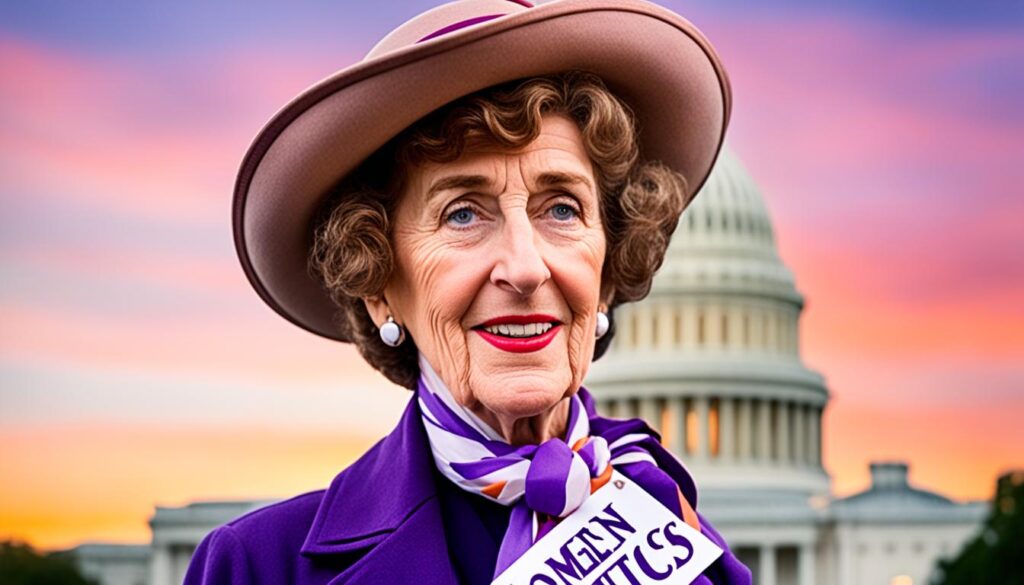Jeannette Rankin made history in 1916 by becoming the first woman elected to the U.S. Congress. This was four years before women got the right to vote with the 19th Amendment. Her election opened doors for future women to serve in Congress.
On April 2, 1917, Rankin took her oath as Montana’s representative. This was a big step for women’s rights and political power. When she won the 1916 election, she said, “I may be the first woman member of Congress, but I won’t be the last.” And indeed, 387 women have followed her lead since then.
Rankin’s election showed the strength of the women’s suffrage movement. It proved women could be leaders and lawmakers. She was a congresswoman before women could vote, challenging old ideas about women’s roles.
Key Takeaways
- Jeannette Rankin became the first woman elected to the U.S. Congress in 1916, four years before women gained the right to vote.
- Rankin served as a representative for Montana and was sworn in on April 2, 1917.
- Her election highlighted the growing momentum of the women’s suffrage movement and the demand for gender equality in politics.
- As a pre-suffrage congresswoman, Rankin challenged traditional gender roles and paved the way for future women in Congress.
- Since Rankin’s historic election, 387 women have served in the U.S. Congress as of 2021.
Jeannette Rankin: First Woman Elected to Congress
Jeannette Rankin was born in 1880 on a ranch near Missoula, Montana. Her family valued education for her. In 1902, she earned a biology degree from Montana State University, a big deal for a woman back then.
After teaching and sewing for a bit, she went to New York in 1908. There, she started the nation’s first graduate program in social work. This move set her up to fight for women’s rights and social change.

Rankin threw her heart into the suffrage movement. She worked hard to get women the right to vote across 16 states. When Montana let women vote and run for office in 1914, Rankin saw her chance to make history.
Many opposed her, but Rankin’s drive won her the election. In 1916, she became the first woman in Congress, winning by 10,000 votes. This victory broke down gender barriers in politics. It opened doors for more women in Montana politics and beyond.
Rankin’s Historic Congressional Career
Jeannette Rankin made history in Congress with her firsts and strong beliefs. On her first day, she voted against going to war in World War I. She said, “I want to stand by my country, but I cannot vote for war.” Despite criticism, she kept pushing for social change.
Rankin worked hard for women and children’s rights in Congress. She started a committee on women’s suffrage. This led to the 19th Amendment, giving women the right to vote.
She was elected again in 1941, at 60, just before the U.S. entered World War II. Rankin voted against U.S. entry in both wars, showing her strong belief in peace. After her second term, she stepped back from politics but stayed active in the peace movement.
In 1968, at 87, she led 5,000 women in a Vietnam War protest in Washington, D.C. This showed her deep commitment to peace and social change.
Pre-Suffrage Congresswoman: Legacy and Impact
Jeannette Rankin was a trailblazer in politics, elected to Congress before women could vote everywhere. She stood strong against U.S. involvement in both World Wars, showing her deep beliefs. Her work in Congress helped women and children, making a big difference in equality and justice.
Rankin was a key figure in the peace movement, active until her 80s. Some criticized her for opposing war, but she stayed true to her beliefs. She believed in doing what’s right, no matter the cost.
Today, Rankin inspires women to lead and stand up for what they believe in. In 1985, a statue of her was placed at the U.S. Capitol. Her life’s work shows her as a true pioneer, challenging norms and fighting for a fair world.

Leave a Reply